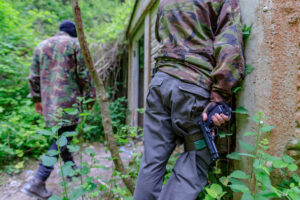As a seasoned photojournalist with a focus on conflict zones, I stand on the cusp of another pivotal journey. My seventeen years in the field have led me to a return to Ukraine, as the nation confronts the third year of Russia’s full-scale invasion. This assignment is a continuation of my on-the-ground coverage in Ukraine in 2022 and my reporting from the volatile Western Balkans — particularly in Kosovo and Serbia. In these regions, I have witnessed firsthand Serbia’s alignment with Kremlin policies and its ensuing territorial and constitutional encroachments on Kosovo. My readiness for this year’s conflict reporting is fortified by the completion of another intensive Hostile Environment and First Aid Training (HEFAT) and Hostile Environment Trauma (HET) course, equipping me with the vital skills needed for reporting in these high-risk areas.
HEFAT, or Hostile Environment and First Aid Training, along with HET, Hostile Environment Trauma training, are critical programs designed to equip journalists with the skills necessary for survival in conflict zones. These courses cover a broad spectrum of essential skills — from risk assessment and situational awareness to emergency first aid and trauma management. They are not just about handling physical threats; these programs also delve into the psychological aspects of working in high-stress environments. In war zones, where unpredictability reigns and dangers lurk in every assignment, such training is invaluable. These courses teach journalists how to navigate hostile territories, respond to injuries,
The video shows a simulated event where a group of trainees, try to administer first aid to civilians in a war zone who are believed to have stepped on a landmine, but then find themselves being kidnapped.

and importantly, manage the intense mental and emotional toll of working under such extreme conditions. For members of the press, undertaking HEFAT and HET is not just a precaution; it’s a vital preparation. It equips them with the necessary tools to not only protect themselves but also to make informed decisions that could potentially save lives, including their own. Skipping such training before entering a war zone can leave journalists profoundly vulnerable, both physically and mentally, severely impacting their ability to report effectively and safely.
The HEFAT course, expertly delivered in Andover, UK, by HET Ltd, is a critical component of my readiness for the unpredictable nature of conflict reporting. Beyond refreshing my skills and witnessing the course’s evolution — a necessary response to the ever-changing tactics of modern warfare — this training has also played a pivotal role in demystifying a personal experience. It helped unravel the enigma of my own rescue in 2012 during the Syrian Civil War, where I faced the harrowing ordeal of being kidnapped while on assignment. This incident, detailed in a gripping account by Vanity Fair, not only underscores the perils inherent in war reporting but also highlights the invaluable nature of HEFAT training. It serves as a stark reminder that such preparation can be the difference between life and death, offering not just survival tactics but also insights into the complex and often perilous dynamics of conflict zones. My journey since 2007, punctuated by such critical experiences, reinforces the indispensable nature of HET and HEFAT training in equipping journalists to navigate the multifaceted challenges of reporting from war-torn areas.
One of the key components of the HEFAT/HET training is the emphasis on practical survival skills essential for operating in hostile environments. The course, led by HET Ltd experts in hostile environments stresses the criticality of not only having appropriate training but also selecting the right protective gear for deployment in such zones. Demonstrating various helmets, the instructor elucidates the balance between safety and mobility, highlighting that a £140 helmet, though costly, can be a vital lifesaver in riot situations.
The training further delves into the intricacies of managing riot scenarios and comprehending crowd dynamics. Participants are enlightened on law enforcement strategies, the psychological underpinnings of crowd behaviours, and techniques to maintain safety while reporting these volatile events. Through real-life examples and technical insights, the course starkly underscores the unpredictability inherent in conflict zones, equipping journalists with both knowledge and practical skills to navigate these challenging environments effectively.
In the comprehensive HEFAT course, a significant emphasis is placed on understanding and mitigating the risks posed by non-lethal weaponry and chemical agents like tear gas. Trainees, including seasoned journalists and newcomers, are instructed in the critical use of protective gear, such as respirators and goggles, and taught self-decontamination procedures following exposure. These practical sessions underscore that such skills are not mere theoretical knowledge but vital tools for survival on the front lines.

The photograph provides a comprehensive view of a training session, where experts, dressed as gunmen in balaclavas, enact the abduction of trainees. This scenario is intended to educate them about the risks of kidnapping, whether for ransom or political motives, in hostile settings. This exercise is an essential element of the Hostile Environment Awareness and First Aid Training (HEFAT) module, conducted in Andover on Thursday, May 26, 2022. (VX Photo/ Vudi Xhymshiti)
As the training progresses into its third day, the intensity escalates, simulating the realities of a war zone. Participants are confronted with scenarios that test their preparedness for high-risk situations — from avoiding profiling and handling abduction risks, whether for ransom or political motives, to understanding the stark implications of these scenarios on their safety, potentially a matter of life and death. The course provides guidance on navigating the complexities of war zones, including how to react if wounded, the protocols for crossing armed checkpoints controlled by either regular military forces or random gunmen, and making critical decisions under extreme stress, such as when to use a vehicle to escape danger.
Beyond the immediate concerns of personal safety, the course also addresses broader responsibilities. Participants learn not only how to accomplish their mission — whether it be journalistic, humanitarian, medical, or voluntary — but also how to do so responsibly and safely, with the goal of not just surviving but also aiding others when necessary. This training is invaluable, providing those venturing into conflict zones with a realistic understanding of the challenges they will face, the responsibility they bear, and the strategies to successfully navigate these hostile environments while maintaining their integrity and purpose.
As the intensive five-day HEFAT training drew to a close this February, I was struck by the profound reminder that war reporting transcends mere fieldwork. It demanded an unceasing adaptability to ever-changing scenarios, a deep comprehension of the human aspect of conflicts, and a commitment to ethically conveying the stories of those ensnared in the throes of war. This training was not just a preparatory step; it represents a continuous educational journey, crucial for navigating the complexities inherent in conflict reporting.
Armed with these insights, I am poised to undertake my next reporting journey to Ukraine. My previous assignments in Kosovo, Moldova, Ukraine, Armenia, and various regions of the Middle East and North Africa since 2007 have laid a solid groundwork. Yet, each new assignment unfolds its unique set of challenges. In the field of journalism, especially in war zones, preparedness is paramount, and the knowledge and skills acquired through HEFAT are indispensable to this readiness.
On this occasion, I must underscore the critical role of organisations like the Rory Peck Trust Foundation. Their support for independent photojournalists like myself is invaluable, particularly as media budgets shrink and the financial burden of war reporting increasingly falls on individual reporters. The Rory Peck Trust Foundation‘s funding of my five-day course was not just a professional aid but a lifesaving gesture. It highlights the essential need for such support systems to ensure that the stories of the most vulnerable in war-torn regions continue to be told with the diligence and empathy they deserve.
In an era marked by relentless conflict, the journalist’s role as an observer and chronicler has never been more crucial. Equipped with a wealth of experience, rigorous training, and an unwavering dedication to truth, journalists venture into these turbulent zones not merely as passive spectators but as active conveyors of reality. They shoulder the responsibility of amplifying the voices of those ensnared in the crossfire of global strife, ensuring that their stories are heard and their experiences acknowledged. In doing so, they uphold the tenets of journalism, shedding light on the often overlooked or misunderstood aspects of these conflicts, and providing a crucial perspective on world events.
Vudi Xhymshiti, founder and chief editor of The Frontliner Magazine, brings a wealth of experience in reporting on global armed conflicts and political issues. With a background in Documentary Photography and Photojournalism from the University of the Arts London, and studies in Political Science, International Relations, and Diplomacy, Vudi skilfully merges human rights insights with dedicated journalism. His ethical and thoughtful reporting has graced top publications like The Guardian and The New York Times. At The Frontliner, launched in 2023, he explores the profound effects of conflicts on law, human rights, and freedoms, continuing his commitment to impactful storytelling.


